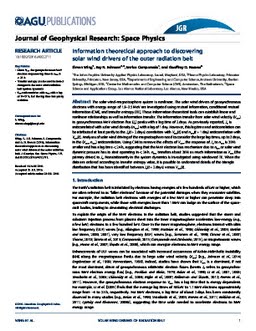2016-10-01
Information theoretical approach to discovering solar wind drivers of the outer radiation belt
Publication
Publication
Journal of Geophysical Research: Space Physics , Volume 121 - Issue 10 p. 9378- 9399
The solar wind-magnetosphere system is nonlinear. The solar wind drivers of geosynchronous electrons with energy range of 1.8–3.5 MeV are investigated using mutual information, conditional mutual information (CMI), and transfer entropy (TE). These information theoretical tools can establish linear and nonlinear relationships as well as information transfer. The information transfer from solar wind velocity (Vsw) to geosynchronous MeV electron flux (Je) peaks with a lag time of 2 days. As previously reported, Je is anticorrelated with solar wind density (nsw) with a lag of 1 day. However, this lag time and anticorrelation can be attributed at least partly to the Je(t + 2 days) correlation with Vsw(t) and nsw(t + 1 day) anticorrelation with Vsw(t). Analyses of solar wind driving of the magnetosphere need to consider the large lag times, up to 3 days, in the (Vsw, nsw) anticorrelation. Using CMI to remove the effects of Vsw, the response of Je to nsw is 30% smaller and has a lag time < 24 h, suggesting that the MeV electron loss mechanism due to nsw or solar wind dynamic pressure has to start operating in < 24 h. nsw transfers about 36% as much information as Vsw (the primary driver) to Je. Nonstationarity in the system dynamics is investigated using windowed TE. When the data are ordered according to transfer entropy value, it is possible to understand details of the triangle distribution that has been identified between Je(t + 2 days) versus Vsw(t).
| Additional Metadata | |
|---|---|
| doi.org/10.1002/2016JA022711 | |
| Journal of Geophysical Research: Space Physics | |
| Organisation | Multiscale Dynamics |
|
Wing, S., Johnson, J., Camporeale, E., & Reeves, G. (2016). Information theoretical approach to discovering solar wind drivers of the outer radiation belt. Journal of Geophysical Research: Space Physics, 121(10), 9378–9399. doi:10.1002/2016JA022711 |
|

